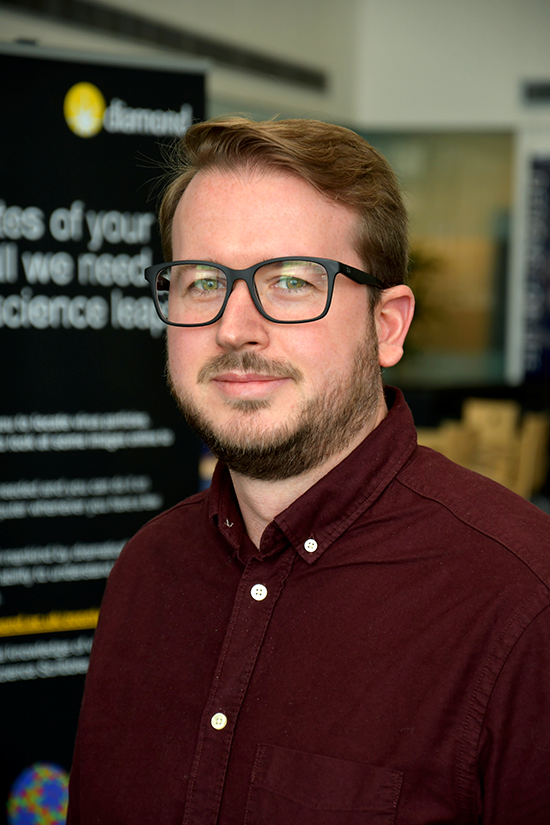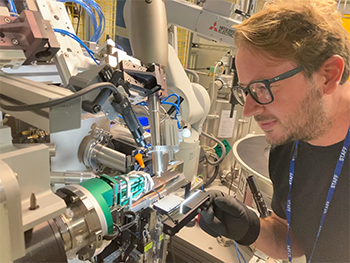___________________________________
Industrial Liaison Group:
Tel: +44 (0) 1235 778797
E-mail: industry@diamond.ac.uk
Supporting industrial clients in their use of Macromolecular Crystallography (MX)
 In this series of articles, we would like to introduce to you members of the Industrial Liaison team. They perform an important role within Diamond, working with our industrial clients to make sure they quickly achieve actionable results to meet their organisational needs.
In this series of articles, we would like to introduce to you members of the Industrial Liaison team. They perform an important role within Diamond, working with our industrial clients to make sure they quickly achieve actionable results to meet their organisational needs.
In this article, we shine a spotlight on Christofer Bjorkelid, an industrial liaison scientist, responsible for helping  companies with Macromolecular crystallography (MX) experiments at Diamond.
companies with Macromolecular crystallography (MX) experiments at Diamond.
Christofer is a specialist in using MX for structure-based drug development. His main role is to provide support to industrial users wishing to use MX research techniques at Diamond to solve their industrial challenges. He has worked in a number of facilities across various countries and brings a wealth of experience to Diamond's MX team.
 Tell us how you came to work at Diamond?
Tell us how you came to work at Diamond?
I completed my PhD at Uppsala University in Sweden involving a structure-based drug development project aimed at finding new antibiotics. I then moved to Singapore and stayed 3 years as a post-doc at Nanyang Technological University working with fragment-based techniques for cancer drug development as a senior structural biologist. After this, I moved back to Sweden to work in an industrial setting at the biopharmaceutical company Sobi. After 3 years at Sobi I moved to the UK to take the position at Diamond. I have been here since Feb 2020.
 What does your typical day-to-day work look like?
What does your typical day-to-day work look like?
A typical day for me involves quite a lot of user support. This can be anything from sample registration and shipments to experimental questions and beamline setup. I also do a lot of service work for our industrial users. This can be data collection at one of our MX beamlines or crystallisation experiments in our crystallisation facility.
 Which industries do you work with?/
Which industries do you work with?/
I work mainly with pharmaceutical companies. Anything from large multinational companies to small local start-up companies.
 What are the key challenges that these industries face?
What are the key challenges that these industries face?
Structural data is a key part of the research pipeline in drug discovery. When using macromolecular crystallography for this purpose the main challenges are producing well-diffracting crystals and collecting high-quality diffraction data from these. When working in such a highly competitive industry, being able to overcome these challenges efficiently can mean the difference between a successful or abandoned project.
![]() How does Diamond support the research of these companies?
How does Diamond support the research of these companies?
Diamond's beam intensity, the advanced data collection capabilities of its MX beamlines, and dedicated expertise of the MX industry team, combined with its on-site support facilities - such as the crystallisation facility and the membrane protein laboratory - gives users the support and flexibility to push their research forward.
 How does the Industry team add value?
How does the Industry team add value?
We are experienced structural biologists, having worked with drug development projects in both academic and industrial settings. The team are always on hand to provide support and assistance and we're able to tailor our services to suit our customers' research. We understand the needs and challenges of our industrial users and are able to guide them to get the most out of their research at Diamond.
 What is the most challenging part of your job?
What is the most challenging part of your job?
Managing and supporting many projects at the same time has its challenges and can sometimes leave little time for the more technical aspects of beamline operations. Luckily, we have very experienced beamline scientists that are able to support us with this.
 What is the most rewarding part of your job?
What is the most rewarding part of your job?
When the user is able to get the diffraction data they need to determine that sought-after structural model.
 Are there any stand-out projects?
Are there any stand-out projects?
I was recently involved in a project where I had set up a large set of crystallisation experiments for one of our users, but we were only able to get a few very small protein crystals. Thanks to the advanced data collection capabilities at the I04 beamline, using X-ray centring and a micro-focus beam, I was able to get a dataset with sufficient data quality and resolution to determine the structure of the protein.
 What would you say to other companies thinking of using Diamond's Industry services?
What would you say to other companies thinking of using Diamond's Industry services?
You don’t need to have prior experience with structural biology or X-ray crystallography to benefit from the structural data that Diamond can provide. The industry team is here to guide and support all users at a level that suits their needs.
 If you would like to find out more about Christofer Bjorkelid , our Industry services, Macromolecular Crystallography (MX), or any of the other techniques at Diamond, Get in touch.
If you would like to find out more about Christofer Bjorkelid , our Industry services, Macromolecular Crystallography (MX), or any of the other techniques at Diamond, Get in touch.
You can also follow our work via Twitter and Linked In, and join our mailing list for regular updates.
Diamond Light Source is the UK's national synchrotron science facility, located at the Harwell Science and Innovation Campus in Oxfordshire.
Copyright © 2022 Diamond Light Source
Diamond Light Source Ltd
Diamond House
Harwell Science & Innovation Campus
Didcot
Oxfordshire
OX11 0DE
Diamond Light Source® and the Diamond logo are registered trademarks of Diamond Light Source Ltd
Registered in England and Wales at Diamond House, Harwell Science and Innovation Campus, Didcot, Oxfordshire, OX11 0DE, United Kingdom. Company number: 4375679. VAT number: 287 461 957. Economic Operators Registration and Identification (EORI) number: GB287461957003.